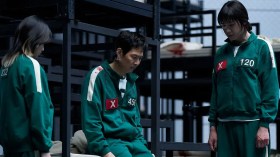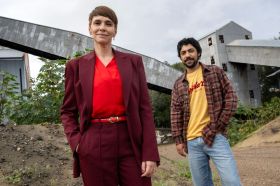Marijuana and hemp stem from the same species of plant but comprise different varieties of cannabis, the latter able to be used for a broad range of things, though not the obvious: making a person high. The billion-dollar crop once flourished in the United States, yet is now illegal to grow, but legal to import. Misunderstandings proliferate with regard to its make-up, including in the media, and to the detriment of its array of purposes. In Bringing It Home, this discrepancy informs directors Linda Booker and Blaire Johnson’s quest for fairness.
Clear and conversational in tone, their documentary is obvious in its position: that the treatment of industrial hemp in the same fashion as marijuana is ludicrous. The first effort for Booker, and the second for Johnson after 2006’s factual short, Mary’s Gone Wild, the film takes its inspiration from the efforts of Anthony Brenner and his daughter Bailey, her rare genetic disorder and sensitivity to chemicals requiring a home constructed from natural products. Accordingly, the filmmaking pair cycle through hemp’s many utilities, their evident support of Anthony’s efforts always apparent. Corralling a legion of fellow allies to speak highly of its functionality, and compiling compelling footage demonstrating its usage, their feature makes its case with conviction.
In Britain, Spain and Ireland, examples of hemp used in construction are offered, its abilities – and its standing as a healthy, safe, mould and fire resistant, carbon-negative alternative – championed by Kevin McCloud, host of TV’s Grand Designs. All over the world, hemp is used in textiles; in America, proponents and designers are forced to import it from China, contributing to the nation’s status as the world’s largest importer. Considered a super crop, it is regarded as one of the best plants to grow, its durability and symbiotic relationship with the environment is lauded. As a food source, it abounds with nutrition, its many variations – milk, oil, powder and more – filled with dietary benefits.
Bringing It Home may be repetitive in espousing its lobbying message; however its examples resound with interest, as do the jovial animated interludes that provide historical and legal context. As the film evolves further into its battle with the law, it only becomes more overt, but passion radiates from the documentary and its assembled interviewed subjects from around the globe. Certainty in the role of consumer choice, of a growing market and desire for hemp products and the change that will follow, also becomes apparent. The film remains defined by its fighting yet optimistic spirit as much as its instructive content.
Booker and Johnson’s many threads of informative advocacy continue to culminate in charting the progress of The Bird’s Nest, Brenner’s hempcrete-built community for his daughter and similarly afflicted children. An emotional response is elicited as the feature returns to its human centre again and again, but absence of subtlety doesn’t diminish its effectiveness. The combination of the facts with a personal plight is carefully edited, showing a finesse otherwise lacking. Bringing It Home makes a compelling case in its endeavours for the legalisation of industrial hemp as a crop in the United Sates, albeit one that is never less than heavy-handed.
Rating: 3 out of 5 stars
Bringing It Home
Directors: Linda Booker and Blaire Johnson
US / Spain / UK, 2013, 52 mins
Transitions Film Festival
http://www.transitionsfilmfestival.com/
15 – 23 February
Actors:
Director:
Format:
Country:
Release:





